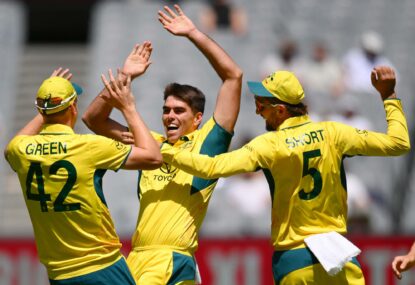The tour of the current West Indies side is making me, like many others, nostalgic for the old West Indies side, when they ruled the cricketing world.
From around 1978 to 1995 the West Indies had the wood on Australia, thumping us regularly in Tests and ODIs here, there and everywhere (i.e. various World Cups).
There were times, however, when we pushed them all the way… notably the 1979 tour by the World Series Cricket Australia side.
It’s easy now to look back on that tour and go “oh it was the last gasp of World Series Cricket” because, well, it was – but it wasn’t when the tour was being organised.
The summer of 1978-79 had been a very good one for the Packer troupe. The quality of games were clearly superior to that offered by the establishment, and Packer had discovered, almost accidentally, his ace in the hole with day-night cricket under lights.
World Series Cricket was getting bullish. Plans were made for the 1979-80 summer, and discussions were held about making overseas tours. One of these would be to the West Indies.
The 1978 official Australian tour of the West Indies, led by Bob Simpson, had cost the West Indies Cricket Board of Control $A110,000, despite the locals winning the test series 3-1.
This was in part because WSC-signed players weren’t chosen for the last three matches, leading to thousands of fans boycotting the games – particularly troublesome in Trinidad, home of the biggest cricket ground in the Caribbean.
New Zealand were meant to tour the West Indies in February and March 1979. But the West Indies Cricket Board wanted a team that was bigger box office, so the Kiwis were booted and World Series Cricket agreed to send an Australian side to play five supertests and twelve ODIs.
This was considered a big advance in World Series Cricket’s bid to gain international acceptance – it would be the first full overseas tour by a World Series Cricket team (though there had been three week trip to New Zealand in November 1978) and it reportedly cost over $A220,000. WSC chose to get approval of the West Indies Board and in return the Board was guaranteed about $A55,000 to develop cricket in the West Indies.
The games weren’t going to be televised but the tour made its money back on crowd admissions and sponsorships. The ODIs would use a red ball, incidentally – not the white one so popularised by WSC under lights.
A squad of 17 Australian players was named on 23 January 1979, during the fourth Supertest of the summer:
Captain – Ian Chappell
Batters – Greg Chappell, Trevor Chappell, Ian Davis, David Hookes, Martin Kent, Bruce Laird
Spinners – Ray Bright, Kerry O’Keefe
Fast bowlers – Gary Gilmour, Mick Malone, Len Pascoe, Jeff Thomson, Max Walker
Wicketkeepers – Rod Marsh, Richie Robinson (also manager)
It was a very strong squad – far more potent than anything the establishment Australians could put into the field, although there were doubts about the batting (Australia’s non-Chappell, non-Hookes batting during World Series Cricket was so wonky that Packer had to import a South African, Kepler Wessels, to boost the top order).
The Chappells, Marsh, O’Keefe, Walker and Lillee had toured the West Indies in 1973; Thommo went in 1978. Trevor Chappell and Martin Kent were chosen because the other members of the then-current WSC Australian team, Kepler Wessels and Ian Redpath, were unavailable: Redpath due to work commitments, Wessels because of his South African passport, which excluded his entry into the West Indies. (Other WSC signees like Doug Walters, Rob Langer and Wayne Prior appear not to have been considered).
Trevor Chappell might have seemed like a nepotistic selection, and he was definitely recruited for WSC over better players, but he’d done well over the summer for the second-tier side, the Cavaliers.
Ian Davis was refused a leave of absence to go on the tour by his employer, the Commonwealth Bank, so he had to pull out. He was replaced by Rick McCosker, whose employer (another bank – the Rural Bank) allowed him leave without pay.
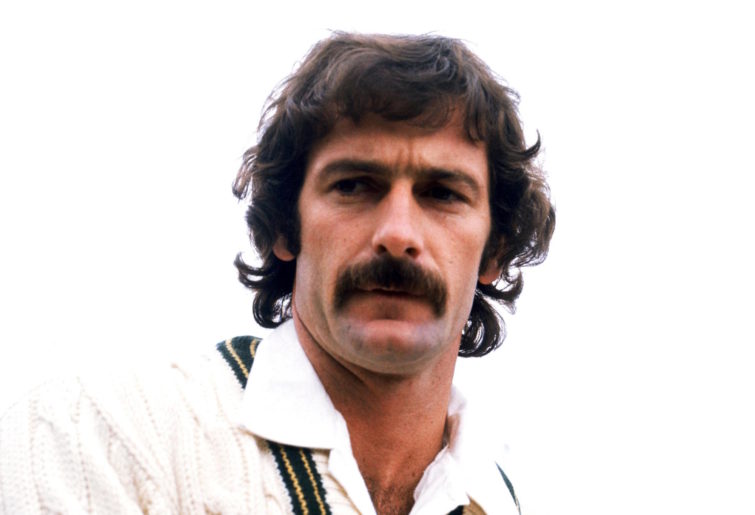
Dennis Lillee is one of Australia’s greatest ever cricketers. (Photo by S&G/PA Images via Getty Images)
There was a lot of excitement about Jeff Thomson’s selection, especially since he and Lillee hadn’t bowled together for Australia since the first Test against Pakistan in December 1976.
Thommo had signed to World Series Cricket back in 1977, but been forced to play establishment cricket by his employer, had an unhappy time, tried to rejoin World Series Cricket in 1978-79 by “retiring” then making a comeback… but he’d been prevented by the courts, at least until his contract with the Australian Cricket Board (ACB) expired on March 31.
This meant that although Thommo would go on the tour, he wasn’t allowed to play until the 5th ODI. However on 9 February the ACB agreed to let Thommo play for the whole West Indies tour. “It’s good news,” said Ian Chappell. “It puts our fire power on the same level as the West Indians.”
Thommo hadn’t played much cricket over the summer apart from 6-18 in a Gillette Cup match, although he won the title for “The Fastest Bowler in the World” in a Channel Nine special that filmed in November 1978 and aired in January 1979 (beating Lillee, Garth Le Roux, Colin Croft, Andy Roberts, Imran Khan and Michael Holding; his best time was 147.9 km/h incidentally – why don’t they have such specials on primetime TV these days?)
For a time it seemed Greg Chappell mightn’t go on the tour. He’d missed the final Supertest in Australia after being diagnosed with Bell’s Palsy, a viral infection of a nerve canal which paralysed one side of his face. Chappell couldn’t close his eye and there was a chance of foreign particles damaging it.
His wife and doctor advised him not to go on the tour, but Chappell was desperate to prove he could make runs against the West Indian attack. It took Chappell a while to recover – he practiced in safety glasses, to ensure no dust would get in his eye – but after a week abroad, he could close his eye again. This would turn out to be the crucial factor of the whole tour.
The Australians left on 15 February – wearing a uniform of short sleeved safari jackets, apparently – and arrived in the West Indies two days later.
Shortly before leaving Greg Chappell told the press, “Australian cricket’s taken a bit of stick this year with the test side being thrashed in the Ashes series and us getting beaten in the Supertest grand final and the International Cup. Despite what some people may say we still feel we are representing our country and we are keen to beat the West Indies for Australia as well as ourselves.”
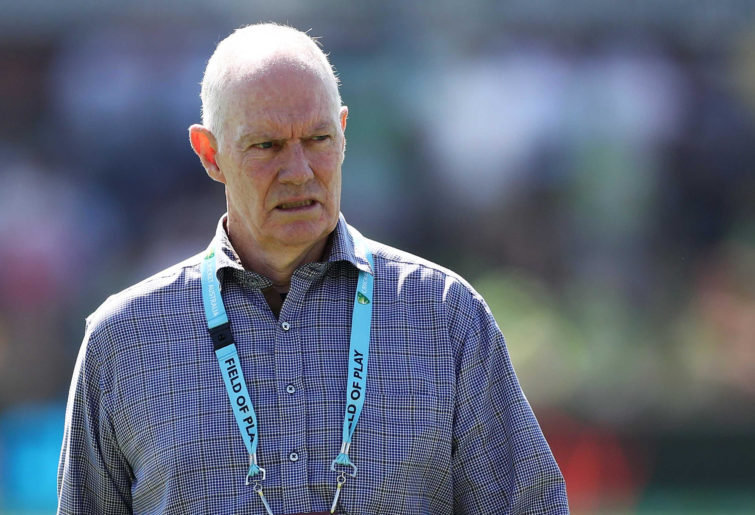
Australian selector Greg Chappell looks on during day three of the Second Test match between Australia and Sri Lanka at Manuka Oval on February 03, 2019 in Canberra, Australia. (Photo by Matt King – CA/Cricket Australia/Getty Images)
They first game was an ODI at Sabina Park, Jamaica (they would only be playing Supertests or one day matches on this profit-conscious tour – no nice warm up games against local sides to help anyone regain form). In front of a crowd of 10,000, the West Indies scored 8-174, with Lillee and Thomson bowling together: Thommo took 3-44. Then Michael Holding dismissed Laird, Ian Chappell and Trevor Chappell in his first four overs and Australia never recovered, reaching 8-138 (Hookes 66, Holding 4-22).
The second ODI was a thrilling game. The West Indies made 132 (Thommo getting 5-31, earning him man of the match) and Australia’s batters didn’t do much better in reply as we stumbled to 8-100. But the tail wagged in support of Greg Chappell (57) – he and Max Walker made it to 9-121, then Walker and Thommo got Australia home by one wicket. What a game!
The first Supertest took place at Sabina Park. Trevor Chappell came in as opener for Rick McCosker, who had broken a finger in the previous game – this meant the Australian batting order featured Trevor, Ian and Greg Chappell, all in consecutive order, which is very cute. The West Indies batted first, making only 188 (Lloyd 56, Lillee 4-68) but Australia wilted in response, collapsing for 106.
Trevor Chappell had to retire hurt when smacked on the chin by an Andy Roberts bouncer (he took six stitches and resumed his innings but for little overall effect on the scoreboard). The West Indies then responded with a second innings of 481 – Lloyd (197) and Andy Roberts (89) putting on a partnership of over 200 runs. That’s the sort of thing that breaks your spirit and it did here – Australia were dismissed for 194 (Bright 47), losing by 369 runs. Ian Chappell wrote this defeat “was hard enough for the more senior players. For youngsters like Martin Kent and Trevor Chappell playing their first international outside Australia, it must have seemed as though they were involved in a new game played only on foreign fields…
“I am sure the 1979 Windies will come to be regarded as the best combination they have put into the field and that it will rank highly in the best ever category. Meanwhile it is the job of the Australians to push on, continue to play our best cricket and not let out spirit be broken by this fine bunch of cricketers.
“If we keep our spirit and fight we can push them to the limit and with a little bit of luck even win the sieges. If we allow our spirit to be broken we will be wiped off the face of the cricketing earth.”
Chappelli gave his team a gee up after the game – which might seem to be something Ian Chappell did a lot but apparently he didn’t (he didn’t have to), his last one being in 1973. He told the players to stop whingeing and said they couldn’t depend on the umpires for protection against bouncers. Ray Bright told Gideon Haigh, “He didn’t really get into us, so as much to say we had it in us to come back”.
Chappelli ended his address with the demand, “Whatever we do, let’s make ‘em respect us.” Leading from the front, Chappelli had decided to promote himself to opener in the second innings and he would stay there for most of the tour – not his favourite position, but someone had to play there.
I don’t worship Ian Chappell the same way many other cricket fans do but you have to admit – this was leadership.
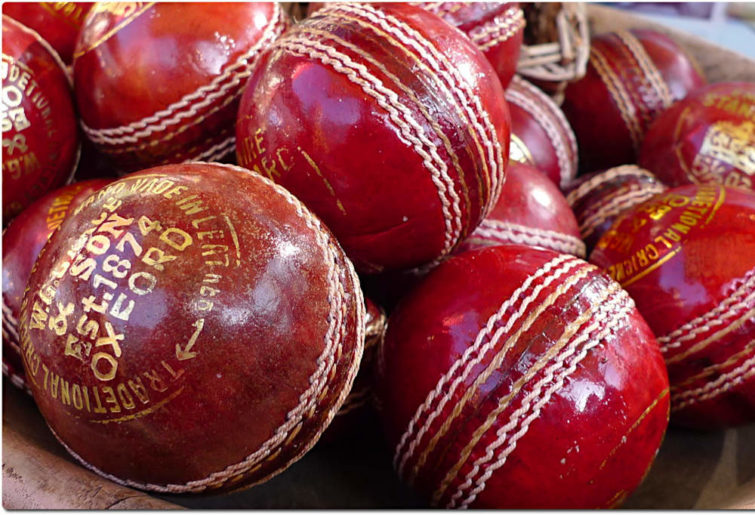
(Credit: Swamibu/CC BY-NC 2.0)
The third ODI, at Castries, St Lucia, was another thriller. The West Indies made 190, Australia struggled to 7-141 but the tail wagged and got to 184 (Laird 56, Lillee 24), just 6 runs short. If this Australian side was outmatched by the hosts, it at least had fight.
After the fourth ODI was abandoned, the fifth, at Bridgetown, was an Australian victory – the batters put on 201 (Greg Chappell 60, Hookes 62, Laird 40), the West Indies were 3-150 when they collapsed to be all out for 159 (Lillee 4-19, Walker 3-24). Spoilers: this was to be Hookes’ last decent performance on the tour.
The sixth ODI sea-sawed. The West Indies made 8-240 (Richards 89), and Australia fell just short at 7-233. Martin Kent, promoted to number three at the suggestion of Greg Chappell, scored 109 and won the man of the match award. It was encouraging, though there were some downsides: Max Walker probably bowled himself out of Test contention with figures of 2-74 off nine overs and Kerry O’Keefe, who hadn’t played a game all tour, was knocked down by a car while on a training run with Mick Malone and broke his leg; he was sent home and Australia were without a leg-spin specialist.
For the second Supertest, at Bridgetown, Australia brought in Len Pascoe in place of Gary Gilmour. Ian Chappell made 61 as opener, Martin Kent kept his good form going with 78, and Australia put on 311. The West Indies scored 239 and Australia responded with 294 (I. Chappell 86, G Chappell 90, T. Chappell 22), leaving the West Indies 366 to get.
On the final day the West Indies were 4-133 (Pascoe 3-20) and Australia in with a good chance to win when the crowd started throwing bottles and rioting.
The match was abandoned at 2.30 pm and ended in a draw. “We had the feeling that any time we got into a position to win there would be a riot,” said Greg Chappell later.
Indeed, ten months prior, a riot had stopped Bob Simpson’s team from beating the West Indies in the 5th test (Thommo played in that game too.) Nonetheless, Chappelli said “I was very proud to be an Australian” after the way his team had bounced back.
The third Supertest, at Queen’s Park, was one of the greatest tests of them all. No kidding. Australia batted first, slumping to 5-32 before Bruce Laird, in one of the great innings (122), and the tail took them to 246. Roy Fredericks told the Australian captain “Tell Bruce I wish I’d played that innings.”
In response, the West Indies made 230, Thommo getting 5-78. Australia’s second innings was again propped up by a defiant lone hand – Greg Chappell’s magnificent 150.
The West Indies had 299 to win – which was tricky, even for them. They went after it, several batters got starts, but Australia kept fighting back. As Lillee wrote in his memoirs “it was nip and tuck all the way, with both teams always seeming to be in sight of victory.”
Thommo and Bright weren’t breaking through, Ian Chappell had a bowl and started taking wickets, the Windies tail wagged, Lillee had to leave the field in exhaustion, the crowd threatened to riot, but the bowlers stuck at it and the West Indies were all out for 274, 24 runs short (Ian Chappell 3-35!)
So the two teams were one-all. The fourth supertest in Georgetown was originally scheduled for five days but heavy rain in the week beforehand led to the organisers reducing it to four. The state of the ground delayed play on day one… delayed it so long, in fact, that the crowd of 15,000, after waiting four hours for the game to start, decided to riot.
Australian and West Indies players were trapped in their dressing rooms while spectators banged on doors and threw bottles through the windows. “We felt pretty vulnerable when the crowd came into the pavilion,” admitted Chappelli later.
When things calmed down, it was decided to cancel the Supertest and play two limited-overs matches instead. However the following morning this decision was reversed and play began, with the match only going three days. Australia batted first, making 341, once against dominated by Greg Chappell (113), with assistance from Kent (51) and the tail.
The West Indies scored 476 (Collis King 110 – his first century in international cricket, Thommo 4-84), then Australia were 3-117 when the game ended in a draw.
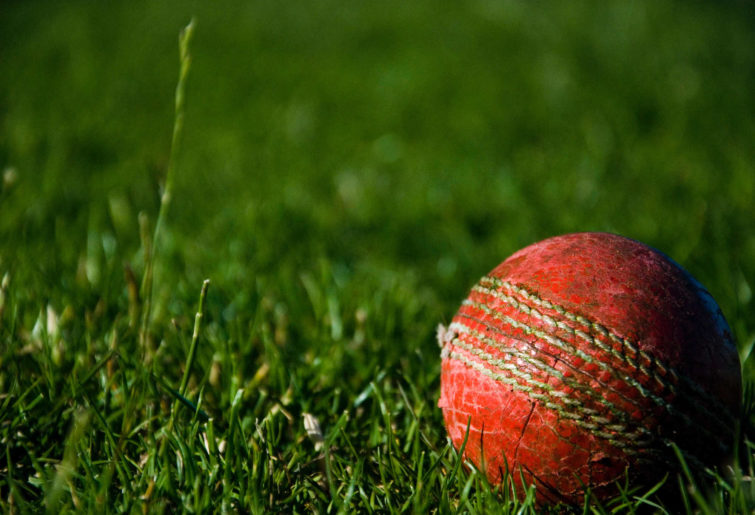
There was some added excitement when Ian Chappell had an argument with WSC Caribbean’s public relations manager, Vic Insanally, over the circumstances that contributed to the riot – apparently Chappelli blamed Insanally for the delay while the West Indian claimed the Australian captain refused to play, after which Chappelli punched Insanally in the stomach and was arrested.
(He pled guilty, paid a fine and wrote a written apology where he said “I was very wrong to do this and I am very sorry that I did so.”).
In the seventh ODI, at Albion, Rick McCosker played his first game since breaking a finger a month earlier. He scored 89 in Australia’s innings of 210. The West Indies chased this down in the last over for the loss of four wickets (Greenidge 95).
The eighty ODI, at Port of Spain was a random game. The West Indies made 206, and Australia were 1-11 when rain stopped play; the match restarted two hours later, and Australia were set 69 to win… they made 6-18. Even worse, Dennis Lillee pulled up during the game with a sore back and it was thought he might have to return to Australia.
The West Indies won the ninth ODI by 54 runs, the tenth by 6 wickets and the eleventh by 8 wickets. Incidentally, Richie Robinson bowled in the latter match and took 1-29! The West Indies had thus won six ODIs in a row.
The fifth and final Supertest took place at St John’s.
Dennis Lillee had damaged his back in that ODI game in Trinidad and was barely able to walk or bend. He was going to return to Australia for treatment but he also knew how much he was needed – a possible replacement, Max Walker, had flown home to be present at the birth of his child – and Lillee’s condition began to improve so he eventually played.
Australia scored 234 (Greg Chappell 104), the West Indies 438 (Lawrence Rowe 135, Lillee 6-125). Australia were in strife at 3-92 but rallied – Greg Chappell 85, Ian Chappell 83, Rod Marsh 102 and Ray Bright 56. They were 6-456 when the game ended in a draw.
A final ODI scheduled for Basseterre, St Kitts on April 13 was washed out. So that fifth Supertest was the final match played under the auspices of the World Series Cricket organisation.
Greg Chappell finished the series with an astonishing 620 test runs at 68.89 (the next highest was Clive Lloyd with 351) – confirmation he really was the best batter in the world at the time. Ian Chappell’s batting was good in the tests (323 runs at 36), bad in the ODIs (68 runs at 9) and his captaincy was amazing.
Dennis Lille’s bowling was splendid (23 test wickets at 28, 11 ODI wickets at 10 with an economy rate of 2.65), which would’ve especially pleased him after breaking down on the 1973 tour. Rod Marsh had a wonderful series behind the stumps and was handy with the bat (252 test runs at 31.5 – he’d never bat as well again in an international series).
So the Chappells did well and Lillee/Marsh. Yeah, yeah, what else was new?
Well, Bruce Laird played that all-time great innings, but only made 200 test runs for the series at 20. David Hookes disappointed in tests (127 test runs at 14). Trevor Chappell (89 runs at 11) didn’t live up to the promise he’d shown in Australia. Martin Kent was a nice surprise – not amazing, but very useful sidekick for the Chappells (296 test runs at 30, 278 ODI runs at 31).
It was thought he’d come of age in international cricket… but in 1979-80 he hit a vein of rotten form and didn’t work his way back into the Australian side until 1981. (Kent was an enigma – he’d have these hot streaks where he’d come across as a truly global class player, then he couldn’t buy a run… and these periods would alternate throughout his career.)
Ray Bright had enjoyed two excellent summers in Australia for WSC, but struggled with the ball in the West Indies (10 test wickets at 40), though was very useful with the bat (237 runs at 39.5). Gilmour, Malone and Walker had their moments in the one dayers (Malone was the most economical Aussie bowler after Lillee), and Pascoe was effective (14 test wickets at 28).
Thommo perhaps had the most buzz about him. He played some excellent games then sort of faded away… but 16 test wickets at 29 isn’t bad, and he was Australia’s leading wicket taker in the ODIs (13 at 18) if also expensive, going at 4.68 an over.

Dennis Lillee (left) and Jeff Thomson. (PA Images via Getty Images)
The old Lillee-Thommo combo magic never really returned, although the two would play alongside each other for a number of other tests.
The West Indies had seven batters who averaged over 40 for the series – Lloyd, Andy Roberts, Rod Fredericks, Lawrence Rowe, Viv Richard, Collis King and Derryck Murray. Their best bowlers were Holding (24 at 21), Croft (20 at 31) and Roberts (13 at 26) but where the hosts really had it over the Aussies was in their batting.
Lillee later wrote “I looked back on that tour with mixed feelings. The riots, the tight schedule and the fact that it came hard on the heels of a really tough summer back home certainly coloured my time in the Caribbean.”
When the players returned to Australia, no one knew that it would be the last World Series Cricket, competition but the compromise was announced in May.
By then an establishment Australian squad had left to play in the 1979 World Cup. In July 1979 another establishment Australian squad was announced to tour India – this one didn’t have any WSC signees (which felt kind of mean). But by 1979-80 everyone was back together again.
And so the 1979 West Indies tour faded from memory, which was a shame. It has changed in recent years, with the publication of works like Gideon Haigh’s superb ‘The Cricket War’ and the emergence of the internet which makes it easier to access old scores.
For what Ian Chappell and his men (well, some of them) accomplished was one of the most impressive Australian cricketing achievements of the 1970s.







































































































